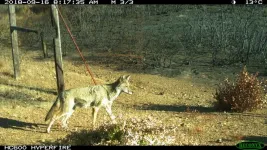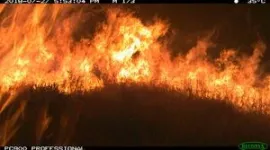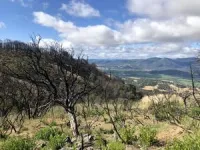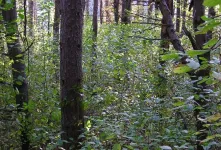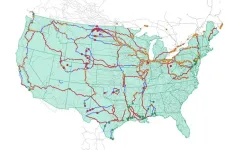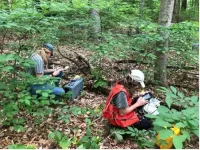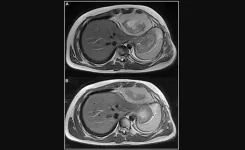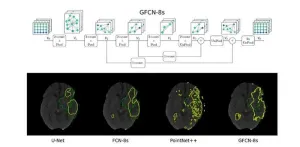(Press-News.org) Berkeley — During the summer of 2018, the Mendocino Complex Fire ripped through UC’s Hopland Research and Extension Center (HREC), transforming the Northern California property’s grassy, oak-dotted hillsides into a smoldering, ash-covered wasteland.
“It felt like something out of the Lord of the Rings — like Mordor. It was hard to imagine much surviving,” said Justin Brashares, a professor of environmental science, policy and management at the University of California, Berkeley.
But mere months after the fire, animals like coyote, gray foxes and black-tailed jackrabbits were seen returning to the area, spotted by grid of motion-sensor camera traps that Brashares’ lab has operated since 2016 at the HREC, a multidisciplinary research and education facility located on the banks of the Russian River about and 13 miles south of Ukiah.
“We were surprised that many species seem to be resistant [to the impacts of the fire],” said Kendall Calhoun, a graduate student at UC Berkeley and a member of Brashares’ lab.
Calhoun is the lead author of a new study that analyzed more that 500,000 camera grid images taken at the HREC in the years before and after the Mendocino Complex Fire to understand how the blaze impacted small- and medium-sized mammals on the property.
The study, which appeared Monday in the journal Ecosphere, is one of the first studies to compare continuous wildlife observations made before and after a megafire. It is also one of a limited number of studies to focus on the impacts of megafires on California’s oak woodlands. Oak woodland ecosystems comprise a large portion of the state, and yet are underrepresented in wildfire research compared to the conifer forests of the Sierra Nevada.
“For the great majority of Californians, these oak woodlands and grassland savannahs are what we think of as the characteristic biome or ecosystem type for our state,” Brashares said. “It's the primary ecosystem type for livestock grazing, and it's also the primary habitat type that's used to grow grapes for wine. It's a critical ecosystem type, and it’s worth managing well.”
Of the eight animal species included in the study, six were found to be “resistant” to the impacts of the fire, using the area in the same ways and with approximately the same frequency as they did before the fire. These species included coyote, black-tailed jackrabbit, gray fox, racoon, striped skunk and bobcat. Western gray squirrel and black-tailed deer, however, appeared to be more vulnerable to the impacts of the fire.
Brashares and Calhoun believe many of the species were able to remain in the area thanks to small patches of tree cover spared by the fire. Photos from the camera traps reveal many animals taking refuge in these patches, using them to obtain food and resources while more heavily burned areas recovered. Some animals were even observed using these locations more often after the fire than before.
These findings highlight the importance of using techniques like grazing and prescribed burning to reduce the intensity of wildfires when they happen. These lower severity fires are more likely to leave the tree canopy intact and create the types of forest heterogeneity that can benefit fire-adapted ecosystems.
“Even this incredibly hot and devastating fire still managed to leave behind these little patches of unburnt areas, and we were surprised at how quickly many species were able to move into those habitat patches and then spread back out into the burned areas as they recovered,” Brashares said. “This finding is very valuable for forest management because we can do things to the landscape that will increase the chance that when fire does come through, it will leave behind some of these fragments.”
An approaching inferno
Calhoun was halfway around the world visiting New Zealand when he received a text message from study co-author Kaitlyn Gaynor informing him that the HREC was on fire.
“I think my immediate text back was, ‘Is everyone okay?’” Calhoun said.
For two years, Calhoun had been helping to maintain the 36 camera traps spread across the property that had been set up in collaboration with the California Department of Fish and Wildlife to test a new way to monitor wildlife populations across the state.
Calhoun had originally joined Brashares’ lab hoping to study impacts of megafire on wildlife diversity, but the unpredictability of wildfire had made it difficult to find a study site. The Mendocino Complex Fire — while terrifying and destructive — provided him with a rare opportunity.
“From what I heard, it was really scary as the fire was coming up to the property because people live on site, so there was a big rush to evacuate. The fire ended up burning more than half of the area,” Calhoun said. “I was a continent away when I found out, but I was interested in hitting the ground running and making sure we got all the data we needed when I got back.”
Calhoun and the team first returned to the site about two months after the fire, when trees were still smoldering and the HREC resembled a “moonscape.” The team’s first task was to check on the cameras, 13 of which had been partially melted by the fire. In addition to replacing broken camera parts, they also checked to make sure the camera traps were set up at the same position and with the same orientation as they were before the fire, to ensure that their data remained as consistent as possible.
Every three months, the team visits all 36 cameras on the site, downloading the photos, ensuring that everything is working correctly and removing any grass or debris blocking the view. They then spend countless hours reviewing each shot to sort out which photos contain animals, then identify the animals and log the data.
“A lot of the data that we collect is just grass blowing in the wind,” Calhoun said.
In addition to small- and medium-sized mammals, the cameras also capture photos of larger animals, like black bears and mountain lions. Because these apex predators have huge home ranges — often many times larger than the HREC’s 5,300 acres — it is impossible to get accurate information about their distributions from the study area.
Calhoun said that, anecdotally, these animals were spotted much less frequently after the fire, suggesting that they were slower to return to the area after the blaze.
After completing his Ph.D. this summer, Calhoun plans to continue his work as a 2023 Smith Fellow, studying how broad changes in fire regimes are affecting wildlife species across California. As part of the work, he hopes to obtain broader scale data on apex predators to better understand what happens to these animals when large fires destroy their home ranges.
“For my next project, I’m really interested in looking at the broadscale effects of fire on those really wide-ranging species, like mountain lions and bears, and then also how wildfires might be impacting their relationship with people,” Calhoun said. “The conflict between bears and humans, especially in Lake Tahoe, is really big in the in the news right now, and I think that either climate change or fire might be driving some of those interactions.”
Additional study co-authors include Benjamin R. Goldstein, Kaitlyn Gaynor, Alex McInturff and Leonel Solorio of UC Berkeley. This work was supported in part by the California Department of Fish and Wildlife (CDFW Grant # P1680002) and by the NSF Graduate Research Fellowship program.
END
Hidden cameras spot wildlife returning home after 2018 megafire
A new study finds that many wildlife species were remarkably resistant to the impacts of the Mendocino Complex Fire in Northern California
2023-07-18
ELSE PRESS RELEASES FROM THIS DATE:
What motivates family forest landowners to manage invasive species?
2023-07-18
URBANA, Ill. — Over half of forests in the United States are privately owned, especially in the Eastern part of the country. This can make control of invasive species challenging, as efforts need to be coordinated among many different landowners. A new study from the University of Illinois Urbana-Champaign looks at how family forest landowners in Maine and New Hampshire approach invasive species management and what factors influence their decisions.
“We have mostly public land on the West Coast and privately owned family forestland in the Midwest ...
Lehigh University Professor Dan M. Frangopol elected into Academy of Engineering of Mexico
2023-07-18
Dan M. Frangopol, the inaugural Fazlur R. Khan Endowed Chair of Structural Engineering and Architecture at Lehigh University, has been elected into the Academy of Engineering of Mexico (AEM) as a Corresponding Member.
According to AEM, the academy was “established to recognize the most accomplished and prominent engineers in Mexico,” and it “selects a number of internationally recognized individuals from around the world with outstanding contributions to engineering following a rigorous nomination and evaluation process.”
An induction ...
UC Berkeley study reveals goal-oriented rewards as key factors in decision-making
2023-07-18
Groundbreaking research from UC Berkeley’s Department of Psychology is shifting the understanding of human decision-making processes by highlighting the importance of goal-oriented rewards. Conducted by Berkeley Psychology Professor Anne Collins and Berkeley Psychology doctoral student Gaia Molinaro, the study suggests that the value people attribute to outcomes is subjective, and heavily influenced by their personal goals and the context of the decision.
"Value isn't just determined by an objective reward or outcome,” Collins said. “Our research suggests that people's perception of value is largely shaped by their personal goals and ...
Virtual rehabilitation program for seniors with frailty shows promise, according to McMaster-led research
2023-07-18
Virtually delivered rehabilitation for seniors living with frailty is a feasible way for delivering care, shows new research led by researchers from McMaster University and the Geras Centre for Aging Research.
The study, published in Pilot and Feasibility Studies on July 17, defined frailty, a consequence of aging, as a decline in function and physiological reserve in multiple bodily systems.
Frailty impacts approximately 1.5 million older adults in Canada, and frail seniors account for a large proportion ...
Safe train transport
2023-07-18
Oak Ridge National Laboratory researchers used images from a photo-sharing website to identify crude oil train routes across the nation to provide data that could help transportation planners better understand regional impacts.
More than 300 crude oil rail incidents have occurred in the U.S. over the past decade, causing adverse consequences from fire and hazardous materials leakage. However, only limited information on the transport routes has been publicly available.
In a study, ORNL researchers used geotagged online photos from Flickr to reconstruct transport paths. By linking geotagged crude oil train images with national railway networks, the team ...
The legacy of past disturbance shapes coastal forest soil stability
2023-07-18
The Science
Coastal forests are increasingly exposed to the effects of climate change and sea level rise. However, scientists have an incomplete understanding of what this means for soil stability. This experiment examined how soil might change when transplanted between parts of a tidal creek that differed in salinity. Scientists found that soils with a history of salinity and inundation by seawater were more resistant to changes in water properties and movement. This suggests that the soils had already “learned” how to adapt to environmental changes. The researchers suggest that differences in the resilience of soils’ carbon ...
Cameron Whitehead wins U.S. Department of Energy’s 2023 CyberForce® Conquer the Hill — Reign Edition Competition
2023-07-18
Unleashing the power of cybersecurity: 2023 CyberForce® Conquer the Hill — Reign Edition competition set the stage for virtual showdown.
In an exciting showdown of talent and skill, Cameron Whitehead of University of Central Florida emerged as the champion of U.S. Department of Energy’s (DOE) 2023 CyberForce® Conquer the Hill — Reign Edition Competition. This virtual event, organized by DOE’s Argonne National Laboratory, involved 144 individual participants from collegiate institutions across ...
Case Report: Intrathoracic synovial sarcoma with BRAF V600E mutation
2023-07-18
“The prognosis of recurrent/metastatic SS remains poor, highlighting the need for a novel therapeutic strategy.”
BUFFALO, NY- July 18, 2023 – A new case report was published in Oncotarget's Volume 14 on July 7, 2023, entitled, “Intrathoracic synovial sarcoma with BRAF V600E mutation.”
Synovial sarcoma (SS) is a highly malignant mesenchymal tumor that occurs mainly in adolescents and young adults. The treatment of SS is multimodal, involving surgery, radiotherapy and chemotherapy. The overall prognosis ...
AAA expands awards program to support students pursuing careers in anatomical sciences
2023-07-18
ROCKVILLE, MD—JULY 13, 2023 – The American Association for Anatomy (AAA) announced the deserving recipients of the AAA Predoctoral Fellowship, the DEI Dissertation Completion Award, and the EUReka EDI Undergraduate Research Award. In 2023, AAA expanded its portfolio of awards, grants, and scholarships by an additional $100,000, now topping out at over $650,000. These opportunities provide much-needed financial support to undergraduate and graduate students, enabling them to conduct groundbreaking research and make valuable contributions to the field.
AAA has continuously demonstrated ...
New geometric deep learning model for detecting stroke lesions
2023-07-18
Ischemic stroke, which occurs when a blood vessel in the brain gets blocked by a clot, is among the leading causes of death worldwide. Fortunately, surgeons now have access to advanced imaging techniques that allow them to visualize the interior of a patient’s brain during a stroke. This helps them pinpoint the location of the clot and analyze the extent of damage to the brain tissue.
Computed tomography-perfusion (CT-P) is one of the most useful imaging modalities in the early stages of an acute stroke. However, it is challenging to accurately identify ...
LAST 30 PRESS RELEASES:
Dynamically reconfigurable topological routing in nonlinear photonic systems
Crystallographic engineering enables fast low‑temperature ion transport of TiNb2O7 for cold‑region lithium‑ion batteries
Ultrafast sulfur redox dynamics enabled by a PPy@N‑TiO2 Z‑scheme heterojunction photoelectrode for photo‑assisted lithium–sulfur batteries
Optimized biochar use could cut China’s cropland nitrous oxide emissions by up to half
Neural progesterone receptors link ovulation and sexual receptivity in medaka
A new Japanese study investigates how tariff policies influence long-run economic growth
Mental trauma succeeds 1 in 7 dog related injuries, claims data suggest
Breastfeeding may lower mums’ later life depression/anxiety risks for up to 10 years after pregnancy
Study finds more than a quarter of adults worldwide could benefit from GLP-1 medications for weight loss
Hobbies don’t just improve personal lives, they can boost workplace creativity too
Study shows federal safety metric inappropriately penalizes hospitals for lifesaving stroke procedures
Improving sleep isn’t enough: researchers highlight daytime function as key to assessing insomnia treatments
Rice Brain Institute awards first seed grants to jump-start collaborative brain health research
Personalizing cancer treatments significantly improve outcome success
UW researchers analyzed which anthologized writers and books get checked out the most from Seattle Public Library
Study finds food waste compost less effective than potting mix alone
UCLA receives $7.3 million for wide-ranging cannabis research
Why this little-known birth control option deserves more attention
Johns Hopkins-led team creates first map of nerve circuitry in bone, identifies key signals for bone repair
UC Irvine astronomers spot largest known stream of super-heated gas in the universe
Research shows how immune system reacts to pig kidney transplants in living patients
Dark stars could help solve three pressing puzzles of the high-redshift universe
Manganese gets its moment as a potential fuel cell catalyst
“Gifted word learner” dogs can pick up new words by overhearing their owners’ talk
More data, more sharing can help avoid misinterpreting “smoking gun” signals in topological physics
An illegal fentanyl supply shock may have contributed to a dramatic decline in deaths
Some dogs can learn new words by eavesdropping on their owners
Scientists trace facial gestures back to their source. before a smile appears, the brain has already decided
Is “Smoking Gun” evidence enough to prove scientific discovery?
Scientists find microbes enhance the benefits of trees by removing greenhouse gases
[Press-News.org] Hidden cameras spot wildlife returning home after 2018 megafireA new study finds that many wildlife species were remarkably resistant to the impacts of the Mendocino Complex Fire in Northern California
